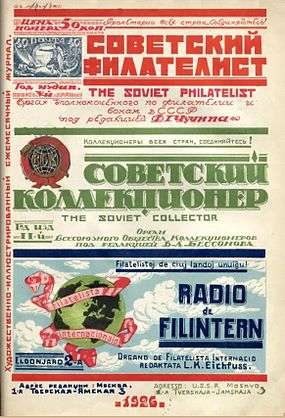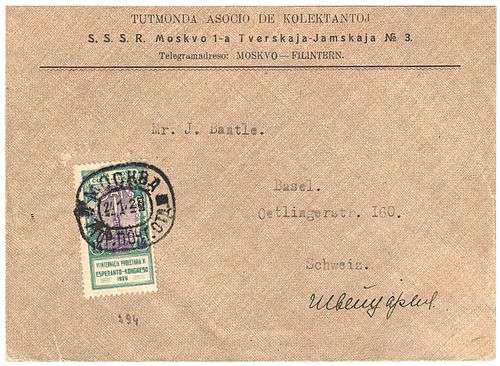Philatelic International
Philatelic International (Filintern)[lower-alpha 2] was an international philatelic society of collector-workers. It was founded and based in the Soviet Union in the 1920s to 1940s.[1][2]
 Emblem of the organisation on the cover of its organ, magazine Radio de Filintern (in the combined issue with Soviet Philatelist and Soviet Collector) | |
| Abbreviation | Filintern |
|---|---|
| Formation | 22 June 1924 |
| Founded at | Moscow, USSR |
| Extinction | 1940s |
| Type | NGO |
| Legal status | international association |
| Purpose | philately, scripophily[lower-alpha 1] |
| Location |
|
| Coordinates | 55°45′N 37°37′E |
Region | world |
Membership (1924) | 102 members |
Official language | Esperanto, English, French, German |
Editor | Leongard Eichfuss |
| Publication | Radio de Filintern |
| Remarks | private persons |
History
The creation of the Filintern was set up at a conference in Moscow in 22 to 30 June 1924. Its formation was greeted by all branches of the All-Russian Society of Philatelists and at the same time by the Soviet Esperantists. At the conference opening, Feodor Chuchin, the Commissioner for Philately and Scripophily, declared:
Within the Filintern and through it we will not only adhere to all the rules of international philatelic ethics but also watch to make sure others uphold them.
A program for the Filintern's central organ was developed that included:
- "propaganda of the international union of philatelist-workers of all nations for the struggle against organised philatelist-dealers",
- "wide popularisation of ideological philately",
- "introducing Esperanto into philately and thus the establishment of lively communication between philatelists around the world."[1]
Filintern facilitates the goals of philatelists, scripophilists[lower-alpha 4] and Esperantists. Within Filintern, they could:
- collect stamps and paper money,
- publish philatelic bulletins, journals and catalogues,
- most importantly, conduct foreign exchange.[1]
Using philately, scripophily and Esperanto, the Soviet authorities also hoped for promoting communist propaganda among the foreign proletariat.[1] Filintern received a further boost from the SAT (Sennacieca Asocio Tutmonda) Congress of 1926.[2]
The Philatelic International's organ was the journal Esperanto: Radio de Filintern. It was an insert included in the monthly magazine Soviet Philatelist or Soviet Collector.[2] Its Editor was a prominent Russian philatelist L. K. Eichfuss. The first issue of the journal appeared in January 1925.[1]
 |
| 1928 Esperanto cover sent from Filintern in Moscow to Mr. J. Bantle in Basel |
See also
Notes
- Collecting stock and bond certificates.
- Russian: Филателистический интернационал (Filatelisticheskii international), brief name being Russian: Филинтерн (Filintern). This was similar to Comintern (Communist International) and Profintern (Red International of Labor Unions).
- Central organ of the Organisation of the Commissioner for Philately and Scripophily and the All-Russian Society of Philatelists (Soviet Philatelist).
- Collectors of paper money, and stock and bond certificates.
References
- Polchaninov, R.; Translated by G. Shalimoff and D. Skipton (1986). "From the history of philately in the USSR". Rossica: Journal of the Rossica Society of Russian Philately. 108–109: 46–52. ISSN 0035-8363. Archived from the original on 2015-05-15. Retrieved 2015-05-15.
Reprinted from 'Novoye Russkoye Slovo', New York, 27 July 1986, in the column 'Collector's Corner'.
- Klein, J. J. (June 1997). "A Filintern cover sent to Montreal". Ямщик [Yamshcik = Post-Rider]. Toronto, Canada: Canadian Society of Russian Philately. 40: 3–5. Bibliographic ID: UF00076781 (University of Florida). Archived from the original (PDF) on 2015-06-14. Retrieved 2015-06-14.
Further reading
- Grant, J. (July 1995). "The socialist construction of philately in the early Soviet era". Comparative Studies in Society and History. 37 (3): 476–493. doi:10.1017/S0010417500019770. ISSN 0010-4175. JSTOR 179216. Archived from the original on 2015-05-15. Retrieved 2015-05-15. Archived from the original and another source on 2015-05-15.
External links
